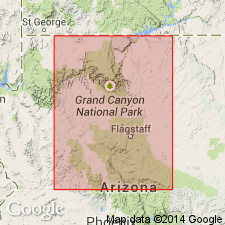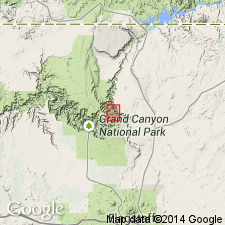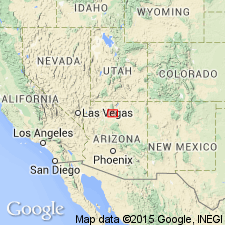
- Usage in publication:
-
- Duppa Member*
- Modifications:
-
- First used
- AAPG geologic province:
-
- Plateau sedimentary province
Summary:
First use of the Duppa Member of the Galeros Formation of the Chuar Group. Marks a return to the argillaceous character of the of the Galeros, with only a few thin scattered limestone beds over a thickness of 570 ft. Siltstone beds up to 3 ft thick are scattered throughout, and toward the top there are thin hematite-cemented sandstones, with well-rounded grains. The rest is shale, generally micaceous, grading into red mudstones toward the top. Age is late Precambrian.
Source: GNU records (USGS DDS-6; Menlo GNULEX).

- Usage in publication:
-
- Duppa Member
- Modifications:
-
- [Principal reference]
- Dominant lithology:
-
- Shale
- Limestone
- Siltstone
- AAPG geologic province:
-
- Plateau sedimentary province
- Southern Rocky Mountain region
Summary:
Pg. 1244 (table 1), 1250, geol. map (fig. 1), columnar section (fig. 2). Duppa Member of Galeros Formation of Chuar Group. Argillaceous shale with thin beds of limestone and calcareous siltstone. Toward top of member are red or purple micaceous silty shale and a few thin sandstone beds. Base of member placed at highest 3+ foot-thick limestone. Total thickness about 570 feet (174 m). No complete section of the Duppa Member could be measured in detail owing to cover of talus on parts of section. Is uppermost member of Galeros Formation (new). Underlies Carbon Butte Member (new) of Kwagunt Formation (new) of Chuar Group; contact is sharp. Overlies Carbon Canyon Member (new) of Galeros Formation. Appears = Walcott's lower divisions 1 and 2a of Chuar terrane [USGS Ann. Rpt. 14, p. 508-509, 1894], and part of Hinds' division 5 of Chuar Group [Carnegie Inst. Washington Pub. 463, p. 105-106, 1936]. Age is late Precambrian.
Type section: Duppa section D, below Duppa Butte in Kwagunt Canyon [labeled Kwagunt Valley on some topographic maps; approx. Lat. 36 deg. 14 min. 15 sec. N., Long. 111 deg. 53 min. 00 sec. W., northeastern corner Walhalla Plateau 7.5-min quadrangle], eastern Grand Canyon, Grand Canyon National Park, Coconino Co., northern AZ.
Named from Duppa Butte, [approx. Lat. 36 deg. 14 min. 28 sec. N., Long. 111 deg. 53 min. 58 sec. W., northeastern corner Walhalla Plateau 7.5-min quadrangle], eastern Grand Canyon, Grand Canyon National Park, Coconino Co., northern AZ.
[Additional locality information from USGS GNIS database and USGS historical topographic map collection TopoView, accessed on September 22, 2024.]
Source: Publication; supplemental information from US geologic names lexicon (USGS Bull. 1520, p. 90).

- Usage in publication:
-
- Duppa Member*
- Modifications:
-
- Adopted
- AAPG geologic province:
-
- Plateau sedimentary province
Summary:
Duppa Member of the Galeros Formation of the Chuar Group of Ford and Breed (1973) is adopted as the Duppa Member of the Galeros Formation of the Chuar Group of the Grand Canyon Supergroup. Age is late Precambrian.
Source: GNU records (USGS DDS-6; Menlo GNULEX).

- Usage in publication:
-
- Duppa Member*
- Modifications:
-
- Age modified
- AAPG geologic province:
-
- Plateau sedimentary province
Summary:
Age of the Duppa Member of the Galeros Formation is modified from late Precambrian to: Proterozoic Y.
Source: GNU records (USGS DDS-6; Menlo GNULEX).

- Usage in publication:
-
- Duppa Member*
- Modifications:
-
- Age modified
- AAPG geologic province:
-
- Southern Rocky Mountain region
Summary:
Is the upper member of Galeros Formation of Chuar Group of Grand Canyon Supergroup. Underlies Carbon Butte Member of Kwagunt. Age designation of Proterozoic Y changed to Late Proterozoic, the age term applied to rocks younger than 900 Ma and older than 570 Ma. Change in age designation made to Galeros and its Tanner (base), Jupiter, Carbon Canyon, and Duppa Members in the Southern Rocky Mountain region of northern AZ. Is 104 m thick. Columnar section.
Source: GNU records (USGS DDS-6; Denver GNULEX).
For more information, please contact Nancy Stamm, Geologic Names Committee Secretary.
Asterisk (*) indicates published by U.S. Geological Survey authors.
"No current usage" (†) implies that a name has been abandoned or has fallen into disuse. Former usage and, if known, replacement name given in parentheses ( ).
Slash (/) indicates name conflicts with nomenclatural guidelines (CSN, 1933; ACSN, 1961, 1970; NACSN, 1983, 2005, 2021). May be explained within brackets ([ ]).

